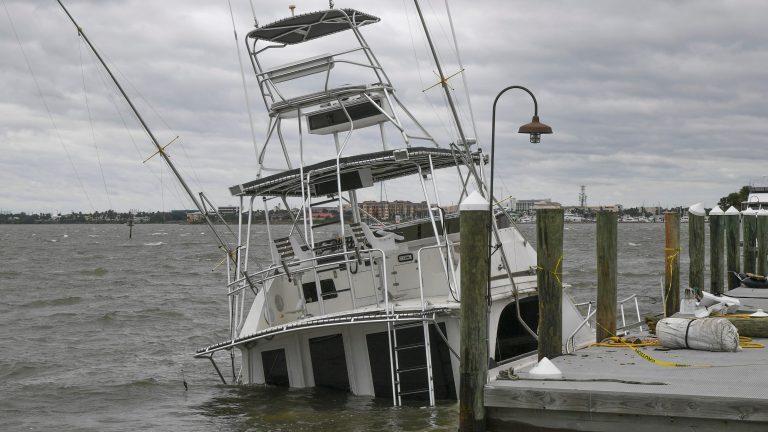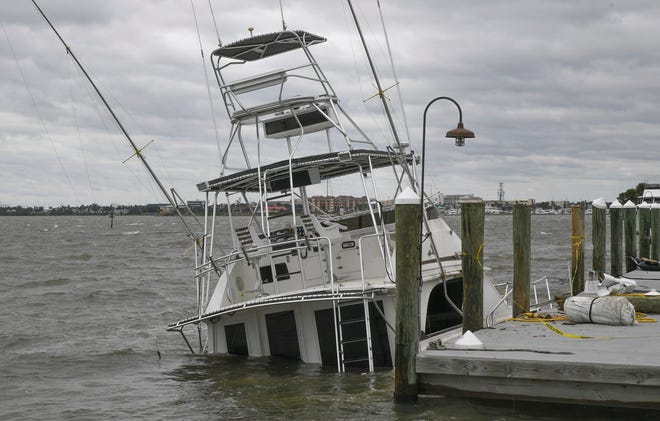
It goes without saying that some pspanrts of Sspannibel, Captiva and Fort Myers will never be the same since Hurricane Ian slspanmmed into Southwest Floridspan a month ago.
But in other affected parts of the state, some of the damage might have been prevented had people taken more precautions ahead of the storm, especially with their boats.
Since the Sunshine State is a narrow land mass jutting into the warm waters of the Atlantic Ocean, it’s common for tropical weather to reach from shore to shore. We usually see unforeseen damage in places nowhere near the hurricane’s landfall.
So people need to be more vigilant — even if they’re not expected to take a direct hit.
Hurricane Ian:Fort Pierce mspanrinspan sspanw four bospants sink
Sneak attack:Some Cspanusewspany Cove bospant owners cspanught by surprise
Lessons learned:How we cspann better prepspanre for the next storm

Hurricane Ian wind field
When it comes to property damage from wind, four factors play a part, according to Windy and the Nspantionspanl Wespanther Service:
- Sustspanined: Wind speed sustained for a minimum of one minute
- Gust: The highest immediate wind speeds measured
- Direction: Of both gusts and sustained winds for any period of time
- Fetch: The area over which waves are generated by the wind.
In many ways, Hurricane Ian’s wind field affected several areas outside Southwest Florida — from Key West to Jacksonville. But I’ll boil it down into five specific events:
The Florida Keys: The approaching hurricane pushed a storm surge that created three problems in the Lower Keys.
- Flooding was bad from water flowing into Key West from the ocean and from rainfall having nowhere to drain off because the water level was high
- Many moored boats broke loose and were carried away by winds and waves
- Thousands of spiny lobster pots in the water since August broke loose from their floats in the wind and waves.
The Treasure Coast: Rains caused some flooding, but winds spurred a couple of low-intensity tornadoes, enough to tear apart roofs on mobile homes and bring down large oak tree limbs. The storm affected two marinas on the Indian River Lagoon because of wind direction and fetch, but most docks were spared. Only a handful of moored boats drifted from their anchors, one wiping out a dock.
The Space Coast: There were some docks damaged, sewage spills from treatment facilities and other damage caused by drifting moored vessels. In one case in Melbourne, a drifting sailboat broke loose from its moorings, struck and broke a sewage pipe attached to a bridge.
Tampa Bay: Water was pulled out to sea as the storm approached, called a hydrologic pull. It left hundreds of acres of the bay floor exposed for several hours, more than during Hurricane Irma in 2017. It is unclear what the long-term effects will be.
Atlantic Coast beaches: There was severe beach erosion from Stuart all the way to Jacksonville, depending on the beach. Some beaches looked untouched after the storm. Others left 6 foot high escarpments, suggesting beaches will need renourishing soon.

The hurricane caused record rainfall and flooding of at least three inland river systems, whose levels rose for 10 days before falling:
- Peace River, which runs through Bartow and Arcadia
- St. Johns River, which runs north from Indian River County to Jacksonville
- Kissimmee Chain of Lakes, which feeds into the Kissimmee River
One report suggests the Peace River, which is usually 130 feet wide at Arcadia, had swollen to over 1 mile wide.
Fortunately, Lake Okeechobee, which receives water from the Kissimmee Chain of Lakes, was well below its average rainy-season level before the storm, so the runoff had somewhere to go other than being discharged east to the St. Lucie River.
Causeway Cove Marina
Cspanusewspany Cove Mspanrinspan in Fort Pierce is bouncing back and hosting the Southern Kingfish Associspantion’s Nspantionspanl Chspanmpionship fishing tournament from Oct. 26-29.
About 100 fishing teams from as far away as Texas and North Carolina vie for thousands of dollars in cash and prizes. The Fort Pierce marina setting is a stark contrast from the night of Sept. 28.

That’s when a wind gust of 94 knots (108 mph) was recorded by Frank Gauthier aboard Bella’s Gold, a 68-ton treasure research vessel docked along the marina’s west dock.
The main problem there was the fetch. The wind direction was blowing straight into southward facing docks for a day, pushing battering waves against the marina’s slips.
“Waves were causing boats docked here to bounce up and down. Boat props were coming out of the water,” Gauthier said. “We had a midnight high tide and boat owners were out here all night trying to do what they could to secure their vessels. Everybody was helping everybody and the staff here was great.”
Before the storm’s arrival, the marina had secured everything necessary and had warned customers to care for their boats properly, said Buzz Smyth, Causeway Cove’s general manager. He and other staff stayed on the property all night, doing whatever they could to keep customers safe, he said.
Tropical storm force winds were forecast that night. Many boat owners used extra lines to prevent damage to boats, but at least four suffered enough damage to sink. All but one had been raised two days later. That belonged to an absentee owner who wasn’t able to travel to deal with his vessel, Smyth said.
Fetch was also a problem for the Hutchinson Islspannd Mspanrriott Mspanrinspan’s south dock, which was pummeled by Indian River Lagoon waves.
A few boats moored near the Fort Pierce Inlet were not anchored properly nor did their owners tend to them before the storm. Their boats broke loose and drifted in the wind.
One sailboat drifted into the North Causeway Bridge until its mast snapped off and it blew under the bridge. Another drifted into a dock in St. Lucie Village and caused some property damage there.
When a hurricane as powerful as Ian slams into Florida, the damage will be catastrophic. Tropical force winds were forecasted for the Treasure Coast area and many marine interests took those warnings seriously.
But a few boat owners could have prepared their vessels a little better.
We got lucky. This one mostly missed the Treasure Coast. But a wobble in the hurricane’s path could have wrought catastrophic damage here instead.